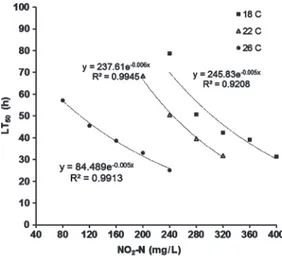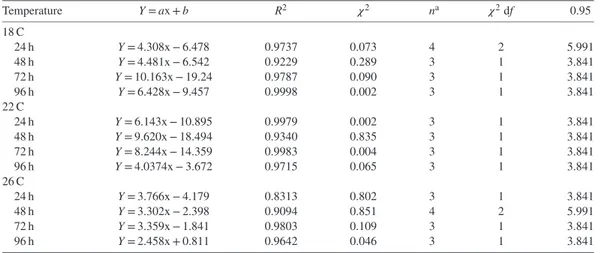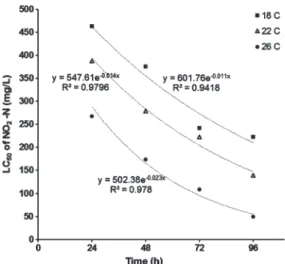doi: 10.1111/jwas.12214
Effect of Temperature on Acute Toxicity of Nitrite to Meagre,
Argyrosomus regius (Asso, 1801)
Mehmet Kir1, Havva Topuz, Murat Can Sunar and Mustafa Topuz Department of Aquaculture, Faculty of Fisheries, Mugla Sitki Kocman University, Mugla, 48000,
Turkey
Abstract
Meagre, Argyrosomus regius, is a candidate marine fish species for aquaculture diversification, presenting a high economic value in the Mediterranean. Tolerance of juvenile meagre to nitrite (NO2-N) was determined relating to temperature. Fish (3.2± 0.6 g and 5.4 ± 0.9 cm) were exposed to different NO2-N concentrations in a series of acute toxicity tests by the static renewal method at three temperatures (18, 22, and 26 C) at a pH of 8.0. Low temperature clearly increased tolerance to NO2-N (P< 0.05). The 96-h median lethal concentration (LC50) values of NO2-N were 177.63, 139.55, and 49.61 mg/L, at 18, 22, and 26 C, respectively. The safe levels of NO2-N for juvenile meagre were estimated to be 17.7, 13.9, and 4.9 mg/L at 18, 22, and 26 C, respectively (P< 0.05). This study indicates A. regius is more sensitive to nitrite than other marine fish species cultured in the Mediterranean.
Meagre, Argyrosomus regius, is considered a candidate species for marine finfish aquaculture in the Mediterranean region, as it presents a high economic value, high growth rate, and excel-lent flesh quality (Poli et al. 2003; Cardeira et al. 2012; Valles and Estevez 2013). Meagre aqua-culture has been carried out since the mid 1990s. Meagre production has increased in recent years with significant production beginning in 2006, a result of captive reproduction (Martinez-Llorens et al. 2011). However, optimal environmental conditions for meagre production are relatively unknown. One important environmental concern is the presence of nitrite in culture systems. Nitrite, a natural component of the nitrogen cycle in ecosystems, is toxic to fish at elevated concen-trations (Lewis and Morris 1986; Jensen 2003; Svobodova et al. 2005)
Nitrite can be actively taken up across the gill epithelium and can accumulate in body fluids (Jensen 1995). One critical consequence of nitrite accumulation is the oxidation of hemoglobin to methaemoglobin, which does not carry oxygen; nitrite may thus cause anoxia in fish (Lewis and Morris 1986). Nitrite toxicity to fish varies considerably by species and depends
1Correspondence to: mkir@mu.edu.tr
on a number of factors. The most important factors are temperature, pH, salinity, and oxy-gen concentration (Brownell 1980; Lewis and Morris 1986; Sampaio et al. 2002; Jensen 2003) Although nitrite toxicity has been well doc-umented for several species of freshwater fin-fish, little information is available on toxicity of nitrite to marine fish species. Previously studied marine fish species include European seabass, Dicentrarchus labrax (Saroglia et al. 1981), gilt-head seabream, Sparus aurata (Parra and Yufera 1999), European eel, Anguilla anguilla (Saroglia et al. 1981; Kamstra 1996), hybrid striped bass, Morone chrysops × Morone saxatilis (Weirich et al. 1993), red drum, Sciaenops ocellatus (Wise and Tomasso 1989), and mullet, Mugil platanus (Sampaio et al. 2002). There is no information about nitrite toxicity in meagre, a potential new species for marine fish diversification of com-mercial aquaculture. The purpose of the study was to determine tolerance of juvenile meagre to nitrite at different temperatures.
Material and Methods
Juvenile meagre (3.2 ± 0.6 g and 5.4 ± 0.9 cm) were obtained from Kilic Holding near Bafa Lake in Turkey. Toxicity experiments were
© Copyright by the World Aquaculture Society 2015
Figure 1. LT50(h) values for juvenile meagre, Argyroso-mus regius, exposed to different concentrations of NO2-N at 18, 22, and 26 C.
carried out at Mugla Sitki Kocman University, Faculty of Fisheries. Ambient water tempera-ture and salinity were 28 C and 30 ppt when fish were transferred. Before the study, fish were acclimated to experimental conditions. Ambient water temperature was gradually decreased from 28 to 22 C. A total of 300 fish, which had been held at a water temperature of 22 C, were distributed randomly into three groups. Each group was than acclimated to 18, 22, and 26 C in different thermostatic aquariums at a rate of 1 C/d for 1 wk.
Nitrite stock solution (30 g/L) was pre-pared with sodium nitrite (NaNO2) (Merck, Damrstadt, Germany) as reported by Chen and Lei (1990) and diluted to the desired con-centrations of NO2-N with 18, 22, and 26 C
seawater. Nominal experimental concentrations of NO2-N in the test solutions were 80, 120,
160, 200, 240, 280, 320, 360, and 400 mg/L. The actual concentrations of NO2-N in test solution were measured using the method described by Bendschneider and Robinson (1952). The pH at each assay solution was regularly measured by a pH 3210 pH meter (WTW, Weilheim, Ger-many) throughout the study. Salinity levels were checked using a salinity meter (YSI model Y30, Yellow Springs Instruments, Yellow Springs, OH, USA).
Short-term median lethal concentration (LC50) toxicity tests were carried out according to the methods described by APHA (1989). Fish were sampled randomly from holding tanks and trans-ferred to the test and control solutions. Bioas-say experiments to establish tolerance limits were conducted in two replicates in polyethy-lene containers containing 10 L test solutions. Each container contained 10 fish, and air stones supplied continuous aeration. Each test solution was renewed daily, in accordance with the static renewal method for toxicity tests (Buikema et al. 1982). Feeding of fish was discontinued 12 h before experimental trials. During the experi-ment (96 h), the fish were not fed. Dissolved oxy-gen was maintained above 6 mg/L.
Observations were made at 12 h intervals up to 96 h. Death was assumed when fish were immo-bile, exhibited no opercular movement, and did not respond to mechanical stimulation. Dead fish were removed daily from containers. The LT50 (median lethal time to kill half of the population) and LC50 (median lethal concentration to kill half of the population) of NO2-N and their 95% confidence limits were calculated by the Bliss Probit method (Sprague 1969). The estimated probit line and results of a chi-square test for goodness of fit were computed. Two-way anal-ysis of variance of the general linear model pro-cedure was used to compare differences between survival, temperature, or NO2-N concentration and exposure time. Regression analyses were used to determine relationship between NO2-N
concentration and LT50 values or LC50 values
and exposure time.
Results and Discussion
During the toxicity experiment, no fish died in the control solutions at any temperature. While 10% mortality was observed for fish exposed for 96 h to 80 mg/L NO2-N at 26 C, no mortality was observed in the same test solution at a water temperature of 18 and 22 C during the toxicity experiment. The LT50 values calculated at dif-ferent concentrations of NO2-N in the study are shown in Figure 1. Statistical analysis indicated the LT50had a negative exponential relationship
Table 1. Relationship between probit mortality (Y) and log NO2-N as mg/L (x) at various exposure times and temperature for juvenile meagre, Argyrosomus regius.
Temperature Y = ax + b R2 𝜒2 na 𝜒2df 0.95 18 C 24 h Y = 4.308x − 6.478 0.9737 0.073 4 2 5.991 48 h Y = 4.481x − 6.542 0.9229 0.289 3 1 3.841 72 h Y = 10.163x − 19.24 0.9787 0.090 3 1 3.841 96 h Y = 6.428x − 9.457 0.9998 0.002 3 1 3.841 22 C 24 h Y = 6.143x − 10.895 0.9979 0.002 3 1 3.841 48 h Y = 9.620x − 18.494 0.9340 0.835 3 1 3.841 72 h Y = 8.244x − 14.359 0.9983 0.004 3 1 3.841 96 h Y = 4.0374x − 3.672 0.9715 0.065 3 1 3.841 26 C 24 h Y = 3.766x − 4.179 0.8313 0.802 3 1 3.841 48 h Y = 3.302x − 2.398 0.9094 0.851 4 2 5.991 72 h Y = 3.359x − 1.841 0.9803 0.109 3 1 3.841 96 h Y = 2.458x + 0.811 0.9642 0.046 3 1 3.841
aNumber of concentrations used for calculation of NO 2-N.
Table 2. Mean ± SE LC50(mg/L) of NO2-N for juvenile meagre, Argyrosomus regius at four different temperatures and various exposure times.a
Time (h)
Temperature (C) 24 48 72 96
18 463.50 ± 1.27 376.22 ± 1.14 242.26 ± 1.08 177.63 ± 1.15
22 387.57 ± 1.33 278.59 ± 1.06 223.20 ± 1.15 139.55 ± 1.34
26 268.19 ± 1.26 174.08 ± 1.18 108.58 ± 1.18 49.61 ± 2.12
aMean values are significantly different from each other.
with concentrations of NO2-N. The LT50 var-ied from 25.2 to 57.2 h and from 31.7 to 68.3 h depending on concentration of NO2-N (240–80 and 320–200 mg/L) at 26 and 22 C, respectively, whereas LT50 values ranged between 31.4 and
78.7 h depending on concentration of NO2-N
(400–240 mg/L) at a water temperature of 18 C in the study.
The probit mortalities as a function of log NO2-N concentration are shown in Table 1.
Chi-square analysis showed the probit mortal-ity had a positive linear relationship with log NO2-N concentration, and all estimated lines were satisfactory at all temperature levels. The LC50 values of NO2-N at different exposure times for juvenile meagre and their 95% confi-dence limits are summarized in Table 2. The data obtained in this study clearly indicated tolerance of fish to NO2-N increased with decreasing tem-perature (P< 0.05). The mortality rate increased with increased NO2-N concentrations and
exposure times (P< 0.05). Similar results were also reported for other marine fish species, including European seabass (Saroglia et al. 1981) and gilthead seabream (Parra and Yufera 1999).
The relationship between LC50data,
tempera-ture and exposure time are illustrated in Figure 2. Statistical analysis indicated that the LC50 of NO2-N had a negative exponential relationship with exposure time. Low levels of NO2-N had
no effects but higher concentrations were toxic to the fish at even with as little as 24-h exposure time. After 24, 48, 72, and 96 h of exposure, the LC50 values for NO2-N were 1.7, 2.1, 2.2, and 3.5 times higher at 18 C than at 26 C, respec-tively.
In this study, at which the acute toxicity exper-iments were carried out at a salinity of 30 ppt and a pH of 8.0, the 96-h LC50values of NO2-N for juvenile meagre (5.4 cm total length) were calculated as 177.6, 139.5, and 49.61 mg/L at
Figure 2. Relationship between LC50of NO2-N exposure time at 18, 22, and 26 C.
a temperature of 18, 22, and 26 C, respectively. Saroglia et al. (1981) reported 96-h LC50 val-ues of NO2-N for European seabass (5 cm total
length) were 274, 220, and 154 mg/L at 17, 23, and 27 C, respectively. In the same work per-formed at salinity of 30 ppt and pH of 8.0–8.2, 96-h LC50 value was reported as 812 mg/L for European eel (7 cm in length) (Saroglia et al. 1981). In another study dealing with mullet, the 96-h LC50 value of NO2-N was reported as
35.89 mg/L at a salinity of 30 ppt and a pH of 7.76 (Sampaio et al. 2002). Such large differ-ences in nitrite toxicity demonstrate that among marine fish, there are species-specific mecha-nisms which regulate the toxic effects of nitrite (Wise and Tomasso 1989). In all circumstances, this study indicated meagre appear to be more sensitive to NO2-N than European seabass and European eel but more tolerant than mullet. The 24-h LC50 was reported as 1997 mg/L for 12 d old larval gilthead seabream (Parra and Yufera 1999). In this study, 24-h LC50values of this
tox-icant were calculated as 463, 387, and 268 mg/L for juvenile meagre at 18, 22, and 26 C, respec-tively. It is reported small fish, even larvae, are unlikely to be more sensitive to nitrite than larger fish of the same species (Lewis and Morris 1986).When the fish size or stage was consid-ered not to be significant, it is clearly evident that
meagre is also less tolerant to nitrite than gilt-head seabream.
Sprague (1971) recommended a “safe” level (a concentration of pollutant which has no adverse effect on organisms) might be obtained by mul-tiplying a 96-h LC50 value by a factor of 0.1.
In this manner, a safe concentration can be sug-gested in which organisms can not only survive but thrive. The safe levels of NO2-N calculated for meagre were estimated to be 17.7, 13.9, and 4.9 mg/L at 18, 22, and 26 C, respectively. From the present data, the toxic effect of NO2-N to
meagre appears to be 3.5-fold higher at 26 C compared with 18 C.
From this study, it can be concluded the tox-icity of nitrite to juvenile meagre increases with increasing temperature. Considering previ-ous studies and the results of this work, mea-gre should be stocked at lower densities, due to reduced tolerance of nitrite, compared with other fish species cultured in the Mediterranean such as European seabass, gilthead seabream, and European eel.
Acknowledgments
The authors would like to give thanks to the Kilic Holding Facility and its employees, espe-cially Adalet Ucal, Cengiz Önder and Hüseyin Serdar. This study was approved by the local ethics committee for animal experiments of Adnan Menderes University (Approval number: 64583101/2014/062) and financed with fund-ing from the Scientific Research Projects of Mugla Sitki Kocman University (Project No: 2015/010).
Literature Cited
APHA (American Public Health Association).1989. Stan-dard methods for the examination of waters and wastew-aters, 17th edition. American Public Health Associa-tion, Washington, DC, USA.
Bendschneider, K. and R. J. Robinson. 1952. A new spectrometric method for the determination of nitrite in the sea water. Journal of Marine Research 11:87–96.
Brownell, C. L.1980. Water quality requirements for first feeding in marine fish larvae. I. Ammonia, nitrite and nitrate. Journal of Experimental Marine Biology and Ecology 44:269–283.
Buikema, A. L. Jr., R. R. Niedertehner, and J. Cairns Jr.
1982. Biological monitoring: Part IV. Toxicity testing. Water Research 16:239–262.
Cardeira, J., R. Valles, G. Dionisio, A. Estevez, E. Gis-bert, P. Pousao-Ferreira, M. L. Cancela, and P. J. Gavaia. 2012. Osteology of the axial and appen-dicular skeletons of the meagre Argyrosomus regius (Sciaenidae) and early skeletal development at two rearing facilities. Journal of Applied Ichthyology 28: 464–470.
Chen, J. C. and S. C. Lei.1990. Toxicities of ammonia and nitrite to Penaeus monodon juveniles. Journal of the World Aquaculture Society 21:300–306.
Jensen, F. B.1995. Uptake and effects of nitrite and nitrate in animals. Pages 289–303 in P. J. Walsh and P. Wright, editors. Nitrogen metabolism and excretion. CRC Press, Boca Raton, Florida, USA.
Jensen, F. B.2003. Nitrite disrupts multiple physiological functions in aquatic animals. Comparative Biochem-istry and Physiology Part A 135:9–24.
Kamstra, A.1996. The acute toxicity and sublethal effects of nitrite on growth and feed utilization of Euro-pean ell, Anguilla anguilla (L.). Aquaculture Research 27:903–911.
Lewis, W. M. and D. P. Morris.1986. Toxicity of nitrite to fish: a review. Transactions of the American Fisheries Society 115:183–195.
Martinez-Llorens, S., J. Espert, J. Moya, M. J. Cerda, and A. Tomas-Vidal.2011. Growth and nutrient effi-ciency of meagre (Argyrosomus regius, Asso1801) fed extruded diets with different protein and lipid lev-els. International Journal of Fisheries and Aquaculture 3(10):195–203.
Parra, G. and M. Yufera. 1999. Tolerance response to ammonia and nitrite exposure in larvae of two marine fish species (gilthead seabream Sparus aurata L. and Senegal sole Solea senegalensis Kaup). Aquaculture Research 30:857–863.
Poli, B. M., G. Parisi, G. Zampacavallo, F. Iurzan, M. Mecatti, P. Lupi, and A. Bonelli.2003. Preliminary
results on quality and quality changes in reared mea-gre (Argyrosomus regius): body and fillet traits and freshness changes in refrigerated commercial size fish. Aquaculture International 11:301–311.
Sampaio, L. A., W. Wasielesky, and C. K. Miranda-Filho.
2002. Effect of salinity on acute toxicity of ammonia and nitrite to juvenile Mugil platanus. Bulletin of Envi-ronmental Contamination and Toxicology 68:668–674.
Saroglia, M. G., G. Scarano, and E. Tibaldi.1981. Acute toxicity of nitrite to Sea bass (Dicentrarchus labrax) and European eel (Anguilla anguilla). Journal of the World Aquaculture Society 12(2):121–126.
Sprague, J. B. 1969. Measurement of pollutant toxicity to fish I. Bioassay methods for acute toxicity. Water Research 3(11):793–821.
Sprague, J. B.1971. Measurement of pollutant toxicity to fish: III. Sublethal effects and “safe” concentrations. Water Research 5(6):245–266.
Svobodova, Z., J. Machova, J. Drastichova, L. Groch, V. Luskova, G. Poleszczuk, J. Velisek, and H. Kroupova. 2005. Haematological and biochemical profile of carp blood following nitrite exposure at dif-ferent concentration of chloride. Aquaculture Research 36:1177–1184.
Valles, R. and A. Estevez.2013. Light conditions for larval rearing of meagre (Argyrosomus regius). Aquaculture 376–379:15–19.
Weirich, C. R., J. R. Tomasso, and T. I. J. Smith.
1993. Toxicity of ammonia and nitrite to sunshine bass in selected environments. Journal of Aquatic Animal Health 5(1):67–72.
Wise, D. J. and J. R. Tomasso. 1989. Acute toxicity of nitrite to Red drum Sciaenops ocellatus: effect of salinity. Journal of the World Aquaculture Society 20(4):193–198.


